
Smoking bans, or smoke-free laws, are public policies, including criminal laws and occupational safety and health regulations, that prohibit tobacco smoking in certain spaces. The spaces most commonly affected by smoking bans are indoor workplaces and buildings open to the public such as restaurants, bars, office buildings, schools, retail stores, hospitals, libraries, transport facilities, and government buildings, in addition to public transport vehicles such as aircraft, buses, watercraft, and trains. However, laws may also prohibit smoking in outdoor areas such as parks, beaches, pedestrian plazas, college and hospital campuses, and within a certain distance from the entrance to a building.
Action on Smoking and Health (ASH) is the name of a number of autonomous pressure groups (charities) in the anglosphere that seek to publicize the risks associated with tobacco smoking and campaign for greater restrictions on use and on cigarette and tobacco sales.
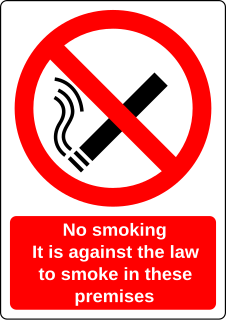
A smoking ban in England, making it illegal to smoke in all enclosed work places in England, came into force on 1 July 2007 as a consequence of the Health Act 2006. Similar bans had already been introduced by the rest of the United Kingdom: in Scotland on 26 March 2006, Wales on 2 April 2007 and Northern Ireland on 30 April 2007.

Ventilated cigarettes are considered to have a milder flavor than regular cigarettes. These cigarette brands may be listed as having lower levels of tar ("low-tar"), nicotine, or other chemicals as "inhaled" by a "smoking machine". However, the scientific evidence is that switching from regular to light or low-tar cigarettes does not reduce the health risks of smoking or lower the smoker's exposure to the nicotine, tar, and carcinogens present in cigarette smoke.

The use of tobacco for smoking in New Zealand has been subjected to government regulation for a number of decades. On 10 December 2004, New Zealand became the third country in the world to make all indoor workplaces including bars and restaurants smoke-free.
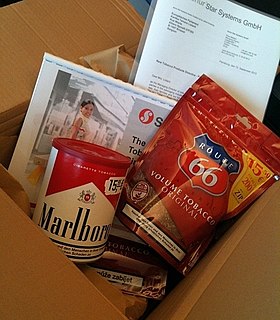
Tobacco politics refers to the politics surrounding the use and distribution of tobacco.

Tobacco control also called anti-smoking, is a field of international public health science, policy and practice dedicated to addressing tobacco use and thereby reducing the morbidity and mortality it causes. Since most cigarettes and cigars and hookahs contain/use tobacco, tobacco control also impacts these. E-cigarettes do not contain tobacco itself, but (often) do contain nicotine. Tobacco control is a priority area for the World Health Organization (WHO), through the Framework Convention on Tobacco Control. References to a tobacco control movement may have either positive or negative connotations.
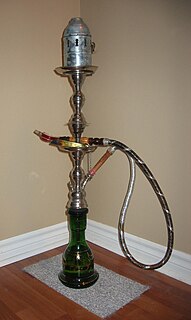
The use of tobacco products in Egypt is widespread. It is estimated that approximately twenty percent of the population uses tobacco products daily. Cigarettes are the most common form of tobacco consumption in Egypt, with an estimated twenty billion cigarettes smoked annually in the country. After cigarettes, shisha water-pipes are the most common form of tobacco consumption. Many Egyptians are not fully aware of the health risks of using a water-pipe and many believe it to be less harmful than cigarettes.
Smoking in Ireland is banned fully in the general workplace, enclosed public places, restaurants, bars, education facilities, healthcare facilities and public transport. However, it is permitted in designated hotel rooms and there is no ban in residential care, prisons and in outdoor areas. Public opinion is in favour of the bans on smoking imposed in Ireland.

Plain tobacco packaging, also known as generic, neutral, standardised or homogeneous packaging, is packaging of tobacco products, typically cigarettes, without any branding, including only the brand name in a mandated size, font and place on the pack, in addition to the health warnings and any other legally mandated information such as toxic constituents and tax-paid stamps. The appearance of all tobacco packs is standardised, including the colour of the pack.

Smoking in Costa Rica is still somewhat prevalent, and according to the Global Adult Tobacco Survey (GATS) in 2015, 8.9% of the population smoked tobacco. The number of people exposed to secondhand smoke indoors while at the workplace was 6.3% while 4.9% were exposed in their own home.

Tobacco smoking in the Philippines affects a sizable minority of the population. According to a 2009 survey conducted under the auspices of the Philippines' Department of Health, Philippine Statistics Authority, the World Health Organization, and the United States Centers for Disease Control and Prevention, 28.3 percent of the population are "current tobacco smokers". This figures represents 17.3 million of 61.3 million adult Filipinos.
Smoking in Tokelau is prevalent, with ethnic Tokelauans having the highest smoking prevalence of all Pacific ethnicities. In the 2011 Tokelau Census, 47.8% of people aged over 15 were found to be regular cigarette smokers.
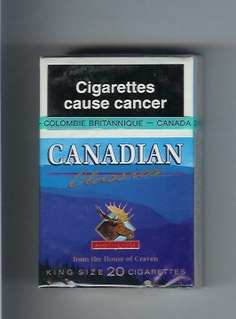
Canadian Classics is a Canadian brand of cigarettes, currently owned by Philip Morris International, and manufactured by its subsidiary Rothmans, Benson & Hedges
Smoke-Free Multi-Unit Housing refers to a ban on smoking tobacco products in multiple‐unit or multi‐unit housing (MUH) complexes, which are defined as a public or private building, or portion thereof, containing two or more dwelling or other housing units including, but not limited to, a building with live/work units, apartment buildings, condominiums, senior citizen residences, nursing homes, housekeeping room/units, residential or single room occupancy hotels, and other multi-unit residential dwellings, group housing, or boarding facilities. According to recent estimates, within the United States, roughly 80 million residents live in multi-unit housing complexes and more than 1 in 3 renters are exposed to secondhand smoke.
Sir David Russell Hay was a New Zealand cardiologist and anti-smoking campaigner.
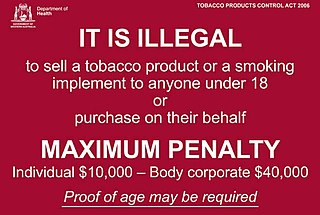
Smoking in Australia is restricted in enclosed public places, workplaces, in areas of public transport and near underage events, except new laws in New South Wales that ban smoking within ten metres of children's play spaces.

Ian Willmore, is a British activist who played a leading role in defending the independence of the civil service in the 1980s. He also campaigned for legislation to ban smoking in public places and standardised packaging of tobacco products.
Karen Louise Chhour is a New Zealand politician who was elected to the New Zealand parliament at the 2020 general election as a representative of the ACT New Zealand party.











